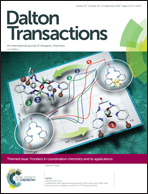Magnetic layered perovskites of [CH3C(NH2)2]2[M(HCOO)4] (M = Co2+ and Ni2+): synthesis, structures and properties†‡
Abstract
We present two layered perovskites of the formula [CH3C(NH2)2]2[M(HCOO)4] (M = Co and Ni). The two materials are isostructural and crystallize in the orthorhombic space group Pccn. The structures consist of anionic 〈100〉-oriented perovskite or square metal-formate layers and interlayer [CH3C(NH2)2]+ cations. In each layer octahedral M2+ ions are linked by equatorial anti–anti HCOO− bridges and are further coordinated by apical monodentate HCOO− groups. The interlayer acetamidinium cations form N–H⋯O H-bonds with the anionic layers to support the 3D structure. As the directions of most vibrations of the interlayer atoms are approximately along the a-axis, the two materials exhibit nearly zero thermal expansion (a few (MK)−1) along the b-direction perpendicularly to the layers and positive thermal expansion along the a- (∼40 (MK)−1) and c- (∼20 (MK)−1) axes parallel to the layers. They are both weak ferromagnets, and the Néel temperatures are 6.0 K and 17.0 K for M = Co and Ni, respectively. The Co compound exhibited high spontaneous magnetization of 444 cm3 G mol−1 under a field of 10 Oe and an unusually low coercive field of 38 Oe at 2 K. IR spectroscopic, thermal and dielectric properties were investigated.
![Graphical abstract: Magnetic layered perovskites of [CH3C(NH2)2]2[M(HCOO)4] (M = Co2+ and Ni2+): synthesis, structures and properties](/en/Image/Get?imageInfo.ImageType=GA&imageInfo.ImageIdentifier.ManuscriptID=C8DT01729H&imageInfo.ImageIdentifier.Year=2018)
- This article is part of the themed collection: Frontiers in coordination chemistry and its applications


 Please wait while we load your content...
Please wait while we load your content...